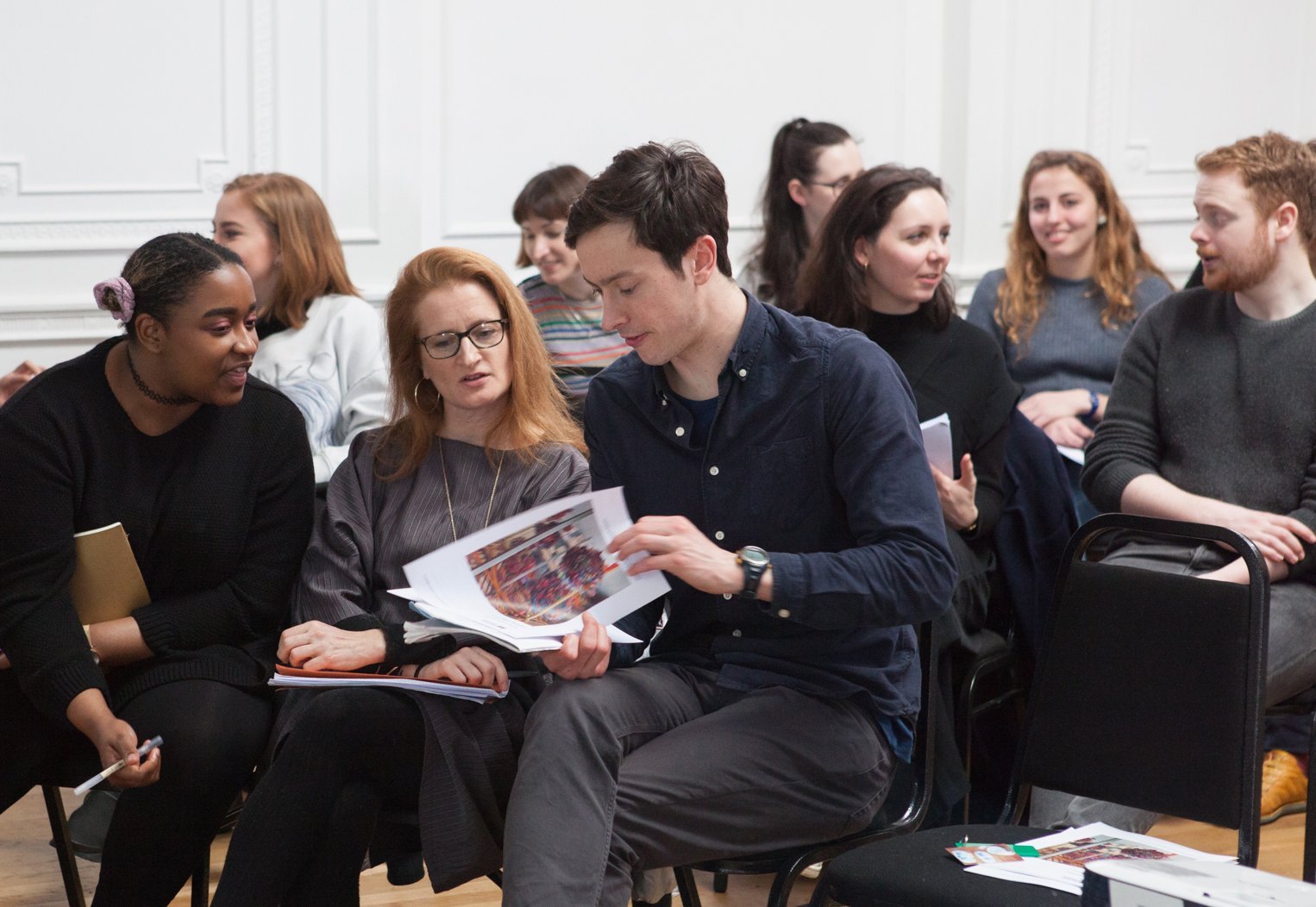
A group of fellows at an induction workshop
Photo: Lucia Scerankova
New ventures in Venice
Many arts graduates are struggling to find employment, but a British Council scheme is helping some to bridge the gap between education and work by spending a month at the Venice Biennale. Laura Broderick and Emma Dexter explain how it works.
While the UK’s higher education sector may be one of the most highly regarded in the world, arts graduates have found themselves facing relatively low employment rates and low average gross annual pay in non-graduate roles (according to the Office for National Statistics, 2013).
In 2014 the British Council established Venice Fellowships, a programme that provides an opportunity for researchers, students and graduates to gain valuable professional experience and contacts outside their existing academic networks, as well as a working insight into the international art and architecture sectors.
While invigilating the exhibition, the fellows were able to immerse themselves in the Biennale and engage in conversation and debate
This skills development takes place at the Venice Biennale, which welcomes thousands of international visitors from industry experts to tourists. Our first programme took place during the 2014 Venice Architecture Biennale. 47 architecture students and recent graduates travelled to the British Pavilion in Venice, where the British Council showcased the very best of art and architecture since 1937.
A professional context
While invigilating the exhibition, the fellows were able to immerse themselves in the Biennale and engage in conversation and debate with a more diverse group than their tutors and peers at home. During designated study days, they explored independent research projects inspired by the exhibition or the context of Venice.
Our fellows develop their existing communication skills in a professional context, an asset recognised by potential future employers within the creative industries. For many of them, being interviewed for the role is also their first formal interview experience.
Working in a team from across the UK and meeting peers at the Biennale’s other pavilions and collateral events, the fellows gain access to national and international networks. The interdisciplinary nature of the fellows – architecture students alongside arts students – further enriches these dialogues.
Preparation and induction
We prepare the fellows with an induction school in London, where they meet their team and the exhibition curators. They are given training on access, communications, customer and exhibition care, as well as talks and workshops from past fellows, artists and academics about approaches to their research. Peer-to-peer learning is a valuable part of the programme so they present their proposals to the group.
Upon arrival in Venice, they receive an on-site induction with the Italian Head Steward and the fellows from the month before. Many enjoy learning about the practical daily role including checking the condition of the artwork.
This year we were delighted to roll out the Venice Fellowships model for the first time during the Art Biennale, enabling us to reach out to new partners, arts courses at higher education institutions and arts organisations, and making this international opportunity available to a wider range of art, design and humanities students.
Through our networks, we recruited 18 partners from across the UK, including the Universities of Dundee, Loughborough and West of England. These partners contribute financial support for the fellows’ stay in Venice and advise on the research aspect.
Feedback and responses
Not only do we encourage dialogue between the fellows, but also between our partners, nine of whom we recently met with. We explored how to further develop the programme and shared feedback about the opportunities afforded to their students and institutions.
The fellows’ research responses take all sorts of forms, from photo essays to salt sculptures and woven nets, and we are always looking for opportunities to share these with the vast audiences that engage with the Venice Biennale online. We set up a Fellowship blog, use social media to share their progress and are planning a project showcase at Bow Arts next year.
Some partners work closely with fellows on their own dissemination events. The University of Salford and Manchester School of Art are collaborating on an exhibition at the International 3 gallery in Salford this November, giving their curatorial students the chance to further embellish their CVs and portfolios.
One of the fellows said: “The experience of meeting curators and seeing world-class exhibitions first hand has developed my knowledge of exhibition practice and management, giving me confidence to bring these ideas, experience and global view to my own practice.”
While it is too early to know the full impact of the experience on the fellows’ future careers, we plan to build an alumni network and are starting to gather formal feedback. Comments show that we could give better guidance on the practicalities of living in Venice and what is possible in terms of research. However, half of the fellows said that the stewarding is excellent or very good for their professional development and over half of them considered the research time to be excellent or very good in terms of contributing to their academic development.
At a time when it can be hard for UK students to bridge the move from academic studies to employment, we hope that this programme can offer a pivotal starting point in planning next steps or having the confidence in career choices.
Laura Broderick is Venice Fellowships Programme Manager and Emma Dexter is Director Visual Arts, both at the British Council.
venicebiennale.britishcouncil.org
Tw @Brit_VisualArts @British_Design #BritishPavilion
Join the Discussion
You must be logged in to post a comment.